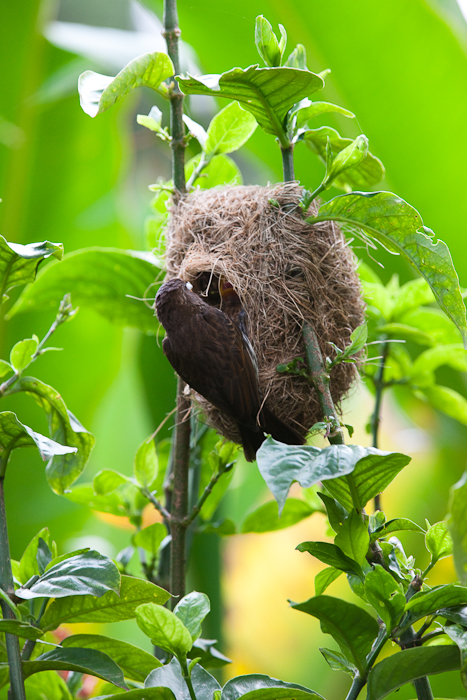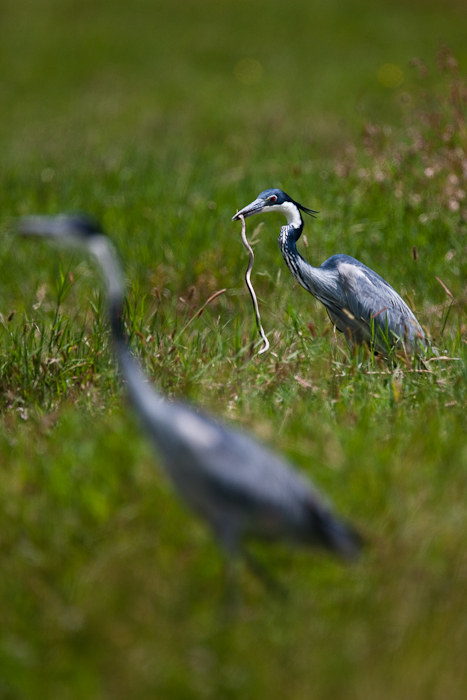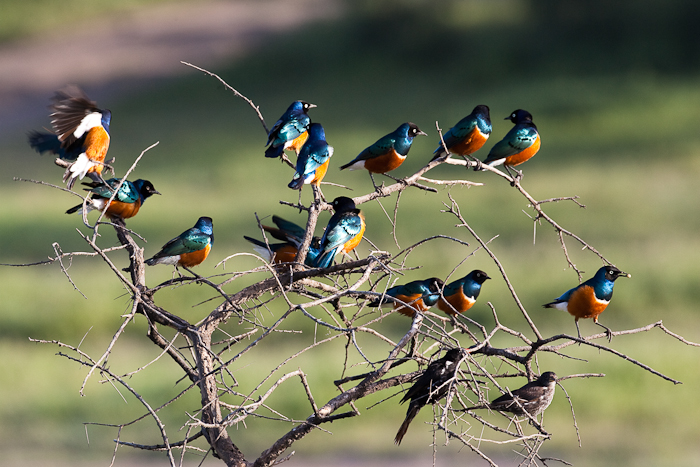Index
Tanzania
2010
The taxi arrived at the ordered time to take me to Schiphol airport for my flight to Kilimanjaro airport. I'm travelling together with a group of 9 others on a photosafari in Tanzania, specifically to Ngorongoro crater, Ndutu and Serengeti. It's just before boarding that I meet up with the others. Two of them I know form an earlier trip to Kenya in 2007. It's an 8½ hour flight and with a two hour time difference we arrive in TZ around 21:30. Three Toyota 4WD jeeps will be driving us around for the next 10 days.
It's an hour's drive to our first hotel and I'm glad to hit the shower and go to bed. We will be rising very early for the remainder of the trip (05:30). The first full day in TZ we are taken to Gibb's farm (www.gibbsfarm.net) to settle in to the African way of life, pole pole (slowly slowly). The accommodation is excellent and so is the food. Some of us are already taking pictures of feeding weaverbirds and it's a treat to see the open beaks of the chicks as they eagerly await a new meal. It's fascinating to see how their nests are built and I have the utmost respect for these birds that only have use of their beaks to produce these wonderful living quarters.

The next day sees us leaving Gibbs to drive up to and into the Ngorongoro crater. The first thing we're treated to is a fairly recent kill of a buffalo by a small group of lions. They're fairly far away and even with a 700mm lens it's not really worth taking a photo. The buffalo must have been a mum as its child is walking alone and is quickly killed by one of the lionesses too. Further on we see the usual stuff like Tommy's (Thompson gazelle), the MacDonald's food of Africa, zebras, wildebeest, ostrich and elephant. A fair number of small and big birds are spotted as well. A grey heron finds and devours a snake.

This is the most likely place to see rhino too and we spot 2 black rhino in the distance. I'm so glad I rented a 500mm f4.0 Canon "cannon" lens. It really pulls in the wildlife to acceptable size on a full frame camera. Coupled with a 1.4 converter on occasion I can get it to 700mm. A bean bag is a must as the contraption together with my camera weighs a whopping 5 kgs (11 pounds). The rhino have enjoyed a mudbath and are now a pale shade of gray.
After a packed lunch we continue our safari in the Ngorongoro and eventually exit it to our next destination Ndutu. It is here that we're allowed to drive off road. To really see wildlife up close this is a must. Most parks in Africa will not allow you to do this and serious fines are handed out. We will be camping for the next four nights at http://www.kuhamacamp.com/. It's literally in the bush so when you're done with dinner, and all turn in to go to sleep at around 21:15 you must be accompanied by staff to your tent. You're not allowed to venture out of your tent by yourself unless the sun is up. The following evenings testify to why it can be d angerous to be outside. We encountered buffalo, lion and hyena in the very near vicinity of our tents.
To be honest the game drives start early in the morning, departure at 06:30 and we return just before dark 18:30. Bedding down for the night around 2130-2200 is late enough for most of us. Ndutu is not the place to be if you want to see really large herds of wildebeest, zebra and or gazelles but what it lacks in numbers it certainly makes up for in variety of species and action. Again I'm very blessed on this trip to see some action.
We spot a large group of lions, eight 1 year olds, a male and 3 females feasting on a wildebeest. The vultures are gathering in numbers. A fairly large portion of the lions decide to move on and we're hoping they'll go for the lake to have a drink so we follow them. Alas they go to their usual resting place so we decide to move back to the location of the kill. We were gone for approx 40 mins or so and when we returned all we saw was as mass of vultures.
Besides a dark brown patch of dried up blood I couldn't spot 1 bone of the wildebeest. It seemed to have evaporated. In the afternoon, after driving around for what seemed hours of 'nothingness' we see three cheetahs lying under a bush. Our jeep had taken a detour to get to the cheetahs. On our way in we passed a group of approx 15 wildebeest and lo and behold they were on the 'wrong' path. As soon as they approached the three lazy hunters the atmosphere changed.
Three sets of ears pricked up and three sets of eyes picked out 1 wildebeest. Pandemonium broke out and within 5 to 10 seconds it was all over. A wildebeest was down. One Cheetah held its throat closed as the two others started to rip in to its loins. What a feast and we were sitting at a distance of not more than 15 metres away from it all. Of course this event happens countless times a day but to be there in the right spot and at the right time is truly a treat and not often witnessed by people.
The following day we see two lionesses sleeping in a tree but the sun is against us and it is jam packed with jeeps. Later that day we return to the same spot and not a lion to be seen. We decide to wait and our efforts are rewarded. An even rarer event is presented to us and even better, there's only our three cars in attendance. A lioness steps out of the bush and a little later she's accompanied by three very young cubs. We've hit the jackpot three times over as she lays down in very short grass to play with and nurse her young.

The bird life is spectacular too and quite difficult to capture, most are small, too far away or take flight as you stop the car. Despite that I manage to capture some superb starlings on a dead tree. It makes my trip worthwhile along with my favourite the Lilac breasted roller. I'm not particularly a birder but I won't skip a photo opportunity if it presents itself.
We transfer to another location in the Serengeti, its plains give access to vast herds of wildebeest and zebra and we capture a group of 50 elephant making their way to where we are parked. Offroading is not allowed here. Four in the group go for a balloon trip and we'll catch up with them later in the day. The hippo pools are quite a spectacle and we can exit the cars to view them. One of the pools has roughly 150 hippos in it.
We get to see a leopard too and a tortoise walking on the road. Crossing the road in an ungainly fashion is a chameleon, unfortunately we can't exit the car to get a good picture of it. It's nearing the end of our trip and we visit a masai village and get to know a little bit of their way of life. The roads are mostly made of dirt, only around the capitol Arush do you find paved roads.
We make aour way towards Arusha and refresh ourselves in a hotel near the airport, enjoy a nice dinner and make our way to the airport for our late evening flight back towards Amsterdam. Some 5000 pictures were taken.
- Gear: 2 cameras, 4 lenses ranging from 28 to 500mm, 1.4 converter, laptop, 2 external HDDs.
- Various cables, powerplugs, chargers, cardreaders, CF & SD cards.
- In total 27 kgs, of which approx 5 kgs was clothing, shoes & personal items.
Top Index